
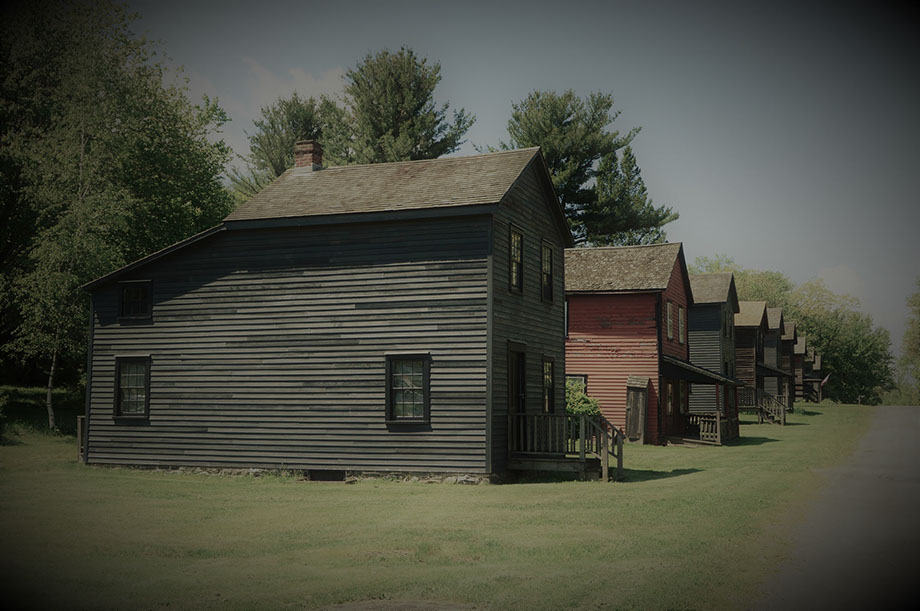
Final Post for Summer 2018
Contributions and Reflections from our Youth Volunteers
By: Kyla Cools, James S., Michael M., Jenson H., and Francine L.
Today we are presenting some thoughts and reflections from our youth volunteers. Our first contributor is with a local boy scout troop and spent about three weeks with us working to earn his archaeology merit badge. We presented him with a few questions about what he’s learned with us this summer, here are his responses below:
James S.
Tell us about archaeology and what you learned! What did you like the most about this? What didn’t you like as much? Why did you come join us in the first place?
I learned a lot. I learned different ways of determining an artifacts age and what they really are. I learned how to dig test units and shovel tests. I had a lot of fun. I like digging and cleaning artifacts. It’s fun digging up dirt and artifacts. During the time I was digging I got to see different types of soil and all the cool artifacts that we find. When I get the chance to clean I can see what the artifacts look like after the dirt and stuff is off. I like cleaning glass and ceramic the most. They look a lot different after they are clean. Archaeology is a lot of fun! Yay!!!!
I didn’t like two things about archaeology. I didn’t like screening or dry brushing. There was a lot of metal. Cleaning it is hard. The dust sometimes flies in my face too. Screening isn’t as bad though. It’s just not my favorite thing to do.
I started doing this because I thought it would be a lot of fun and I was right. I got to do my archaeology merit badge too. I find archaeology really fun. It’s cool too. The people are a lot of fun too. I have become good friends with them. I will definitely be doing this next year.
Our next reflections are from some of our student volunteers from the Hazleton Area Academy of Science. Some are returning volunteers, while others are new to join. All were a pleasure to work with. Rather than pose specific questions to these students, we asked them to think about their experiences with us and write what they feel is most important to share. Read on to see their thoughts:
Michael M.
I’ve always found the past quite intriguing; it’s part of who we are and it defines where we’re going. History has unlimited amounts of potential and information; it’s incredible. When Doctor Shackel and Archaeologist Kyla Cools presented the opportunity to join an archaeology excavation at my school my only question was, “Where do I sign?” I live only fifteen minutes away from the archaeology dig site. It’s a quaint little village in Northeast Pennsylvania known as Eckley Miner’s Village. I had been here many times and was quite familiar with the area, however, what I did not realize was that I was about to see a whole new perspective of the town.
Archaeology also has unlimited amounts of potential and information. I learned a tremendous amount of information in the two weeks I volunteered. The procedures of digging and organization of artifacts are a large amount of what I was taught. I can now thoroughly explain to someone the difference between earthenware and porcelain, something I will take pride in for the rest of my years. I won’t even mention the fact that I have discovered that there is an extensive history of metal nails. All interesting facts aside, I certainly acquired many skills that will serve me through life and that make me a better-rounded person.
I would like to mention how so many high-schoolers have internal, and sometimes external, debates on what they want to do in life. We’re expected to know what we want to do and then pick the perfect college to pursue what we want to do. I can honestly say that archaeology is a study that I would consider. I’ve met outstanding individuals and have had wonderful conversations on topics I didn’t even realize existed. So, whether you’re a freshman in high-school, a freshman in college, or a full grown adult, consider joining up. It doesn’t hurt to have a terrific experience that you’ll never forget.
Jenson H.
Though we can all agree that the excruciating work of carefully memorizing when, why, and how events took place during history class was not the favorite part of our school day, I always loved learning about the events that shaped the world into what it is today. I first found out about this event last year from a friend of mine who had been going for the past few years. He asked me if I wanted to come along and I was eager to go, sadly I was too young. So when the opportunity presented itself a year later to volunteer, I signed up as soon as I had the information.
I thought I already knew a great amount of information about the lives of the people that lived at Eckley coming into this project, but I found out how little I knew about their personal day to day lives. Some people might have seen this newfound knowledge as useless, but that can not be farther from the truth. Learning about Eckley and its people help us to understand a time where people could be slaves without being owned. Mine owners used a number of techniques to keep mining families working for generations.
People wouldn’t be able to comprehend the idea of this today. “Fine, we learned a small fact about how life was worse in the past, so what,” some might say. We learned that we are moving in the right direction, workers have more rights within their workplaces and laws in place to protect them. We use information from the past to make a path for the future. One of the classic cartoon tricks is to have a character seemingly float in midair because they move a plank of wood behind them in front of them, and continue to do so. In the same sense, we take our lessons from the past and put them in front of us, paving our way into the future.
Francine L.
Monday, June 18th kicked off my third year volunteering at the Eckley archaeology dig with Kyla, Katie, Paul, and the rest of the gang. I was somewhat apprehensive about the heat, waking up early, and working hard just after getting out of school for the summer, but by the end of the second day, it had all come back to me—I was glad to be here. A few of the students from last year had returned, which was a huge relief to me. Additionally, as I screened the dirt for artifacts, cleaned the floors of the test unit, and took measurements for paperwork, I grew closer to the new students and volunteers I worked with and learned lessons about far more than archaeology and history.
Before I get into that, I’d first like to summarize what I have learned about the history of my area from this experience. As I’ve lived in a town just a few miles from Eckley all my life, I’d been to my fair share of Eckley’s Patchtown Days festivals and mine tours and museums from all around the coal region. Despite that, nothing has ever brought me closer to my local heritage than touching and seeing up close the things that inhabitants of the area had used decades or even centuries ago. Yeah, sometimes you dig up 256 rusty nails and have to do the paperwork, but that doesn’t diminish the fact that you yourself are digging up, labelling, and cataloging an artifact that you could see in a museum display someday. You are directly contributing to the preservation of local history. It’s amazing and humbling.
It’s also humbling to work with such educated, helpful, interesting people. I have received a huge amount of guidance about college and higher education, even though I am not interested in anthropology as a career. When working with them, I feel as though my work is appreciated and respected, and there’s always a fun conversation (and sometimes shenanigans) taking place. Just from listening to these students I learn a little something new each day, from animals to world events. I hope I’ve taught them some things too; and I hope they realize how much people from my area appreciate the preservation they’re doing.
My fondest memories include eating peanut butter sandwiches and trying adventurous flavors of jams and jellies, receiving compliments from experts about the unit’s walls and floors I cleaned, having hours-long cataloging parties on the porch of the lab, and jamming to Disney songs while finishing up the test unit. I can’t wait to be back next year.
Though this is our last blog post for the summer, be sure to keep an eye on our facebook page for updates from the lab in Maryland! We hope you'll join us on our new adventure in NEPA next summer!
Related Resources
Press & Publications
About
Us
Blogs
Eckley Archaeology Blog - Summer 2018
Week Five 6/25/2018 - 6/29/2018
The Little Flower of Eckley: Gardens and Artifacts
By: Dolly Canevari
When I die, I will send down a shower of roses from the heavens. I will spend my heaven doing good on earth.
This phrase was recited Saint Thérèse de Lisieux, shortly before her death in 1897. And these words were also found on a small pendant, in the backyard of The Rubin House—the property we are now excavating. The front of the pendant bears the Saint’s image encircled by her epithet, Thérèse of the Child Jesus. Thérèse receives this nickname because she entered a Carmelite Convent in France at the age of 14. Initially she was turned down because of her age, so she met with a bishop, but was told that she was still too young. Thérèse was eventually let into the Convent after a formal meeting with Pope Leo XIII.
Saint Thérèse has a few special connections to our archaeology project. Firstly, she is the patron saint of gardeners and florists—Thérèse is often represented by an image of a rose. Eckley may not have had many rose gardens, but the gardens in the miners’ backyards were important sources of food. The Eckley Miners’ Village Museum and oral histories documents how the families had different crops growing over the entire backyards. When speaking with former residents of Eckley, many recall the vegetable gardens that persisted through the 1940s. We are also able to see how important these gardens were in the archaeological record. When we are excavating, we find a very small amount of animal bones. Finding low amounts of bone and faunal remains suggests a low protein diet, so the gardens helped to supplement the family’s food intake.
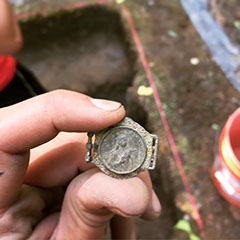
Photo courtesy of Dolly Canevari
St. Thérèse pendant recovered from excavations.
Secondly, Thérèse is a patron saint of the sick and infirmed. The “Little Flower” died at the age of 24 after battling tuberculosis. The property where we were digging was last occupied by the Rubin family from the 1960s through the early 2000s. Anna Rubin grew up on Backstreet and practiced as a nurse and her husband, Jerome Rubin, was a doctor. The couple was based in Philadelphia but lived in Eckley during the summer and helped to combat sickness in region.
Finally, Thérèse is one of the patron saints of Russia. Through census data, field director Kyla Cools was able to find that a Russian-Polish family lived on the property we are excavating in the 1930 and 1940 Federal Census. The parents were both born in America but come from Russian and Polish lineages. We have also found another Catholic medal with writing in Polish!
We are still unsure to whom the pendant belonged. Saint Thérèse was canonized in 1925, so the pendant was created sometime in the last 100 years. But in our last weeks of excavation, as we work to understand the lives of the older occupants of the house, we will keep another phrase of Thérèse’s in mind—Oh, what mysteries will be revealed to us.
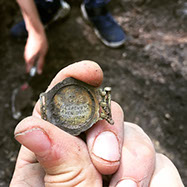
Photo courtesy of Dolly Canevari
Backside of St. Thérèse pendant, showing the aforementioned quote.
The first artifact is a ceramic fragment, representing the rim part of a plate. What interests us about this artifact is the manufacturing technique and the decoration style. Because of its white coloured and homogenous paste, we identify this type of ceramic as whiteware, known to be produced in England since 1820. As for the type of decoration, the blue hand-painted rim is what we call shell edge. Looking back to the history of that motif, we learn that plates with straight rims with impressed repetitive patterns like we see on the picture were particularly popular in the 1840s and 1850s. Since Eckley was founded in 1854, this piece of ceramic is indicative of the first decade of occupation of the village!
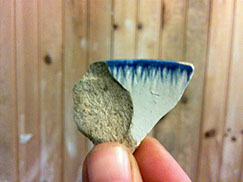
Week Five 6/25/2018 - 6/29/2018
How to date an archaeological site with artifacts: examples from the Rubin House
By: Laurence Bolduc
Artifacts can reveal a lot about people, places and the time period they were made. One recurring question we have coming from the public is how we are able to determine the age of a site, or date artifacts. There are many dating methods or techniques available to historical archaeologist today, but one of the easiest and simplest ways is to look for “chronological markers”. Chronological markers are artifacts indicative of a specific time period based on morphological features, manufacturing techniques, design or specific makers’marks. Some types of objects, like ceramics or glass bottles, change rapidly due to technological progress or simply because they go out of fashion and are replaced by another more popular type. These rapid changes are good for archaeologists!
During archaeological excavations, each artifact is associated with a specific layer in the ground, and according to the presence of these chronological markers, we will we able to date this specific occupation of the site.
Now time to look at some examples from artifacts recovered by our team of archaeologists this field season at Eckley Miners’ Village. While we know that the site was occupied over a span of 150 years, maybe some of these artifacts can help us to trace the exact date of their use.
Photo courtesy of Laurence Bolduc
Impressed shell edge whiteware rim.
These two fragments of amber coloured glass belong to the same bottle of Clorox. The company Clorox was known for its bleach product, used for laundry and cleaning purposes since 1918. What are the most interesting features for us to help date this bottle are the closing type and the lettering on the glass. The form of the finish suggest that the bottle was closed with a cork, a specific closing type used by the company until 1940 when it was replaced by screw cap type of closure. The other revealing element is the embossed lettering on the shoulder of the bottle along with content identification (16 ounces), which according the company’s history, were features introduced in 1933. There you go, we have now a refined date ranging from 1933-1940 for the production – and use- of this bottle!

Photo courtesy Laurence Bolduc
Recovered Clorox bottle finish.
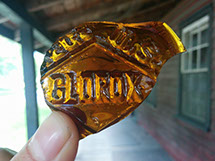
Photo courtesy Laurence Bolduc
Recovered Clorox bottle shard.
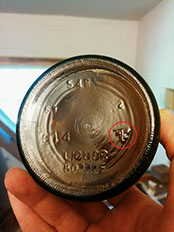
Photo courtesy of Laurence Bolduc
Base of liquor bottle produced by the Thatcher Glass Manufacturing Company.
Lastly, we have here the base section of an amber colored liquor bottle. What is the most interesting element in order to date this machine-made bottle is the glass company’s logo, usually embossed at the bottom of the base. This specific logo is associated with the Thatcher Glass Manufacturing Company from Kane Pennsylvania which opened in 1904. Since we know that the Kane manufacture was closed in 1923, this bottle was possibly manufactured in one of their other plants in New York. Because the company’s logo changed many times throughout their history, it is possible to trace back the use of this specific design between 1944 and 1982. You understand now why we are very excited to find bases of bottles as they hold much dating information!
From these three examples alone, we have a representation of different period of occupation on the Rubin house site, going from the 1850s to the mid twentieth century.
Now you know a little more about our archaeologist’ little secret for dating artifacts!
Thatcher Glass Manufacturing Company logo.
Week Four 6/18/2018 - 6/22/2018
Long Term Mining Impacts
By: Katie Boyle
Week two was quite eventful! We completed the architectural drawings of the Rubin House and then began our archaeological survey. News 69 out of Allentown, PA came to do a piece on our work and Joe and Barbara Michel came for a visit, bringing historic maps and documents of the area. We also had the opportunity to go to Ashley, PA, the site of the former Huber Breaker, to visit with Eastern Pennsylvania Coalition for Abandoned Mine Reclamation (EPCAMR), where Robert Hughes gave us a tour of several Abandoned/Acid Mine Drainage (AMD) sites.
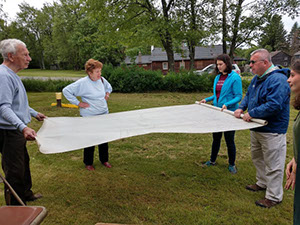
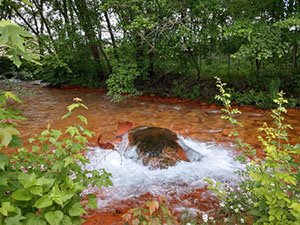
Photo Courtesy of Katie Boyle
Unrolling Joe’s 20’ map showing the road from Hazleton to Eckley.
Photo Courtesy of Katie Boyle
AMD discharge in the Wyoming Valley.
EPCAMR is working to address the long-term impacts of coal mining on the environment through a variety of outreach efforts that raise environmental awareness. The effects of AMD are felt across state lines, as the rivers in this region drain into the Susquehanna River and make their way to the Chesapeake Bay. Each of the sites that we visited showed us orange water welling up from abandoned mines in the Wyoming Valley. The smell of rotten eggs as we approached our first site told us that sulfurous gasses were travelling to the surface as well. These areas are nearly incapable of supporting wildlife, although we did see a very orange snapping turtle at our first site. One of the sites that we visited has a passive treatment system (PTS) that allows for the water to be aerated. This oxygen allows for the iron to precipitate out.
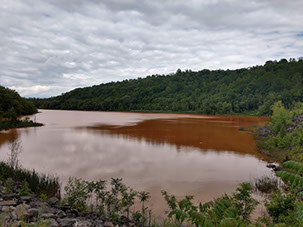
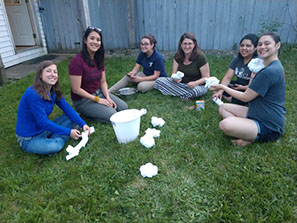
Photo Courtesy of Katie Boyle
Newport Lake, a former stripping pit, which discharges into Newport Creek.
Photo Courtesy of Katie Boyle
Laurence, Kyla, Audrey, Paula, Alessandra, and Dolly preparing to tie-dye shirts using Iron Oxide Pigment.
Robert gave us Iron Oxide pigment for tie-dying t-shirts, which made for a fun crew bonding activity later in the week. This pigment was taken from some of these sites and tested to make certain it would be safe to use. To learn more about EPCAMR’s tie-dye, take a look here. I’m looking forward to adding one to my field shirt collection and being able to tell the story behind it! Stay tuned for updates!
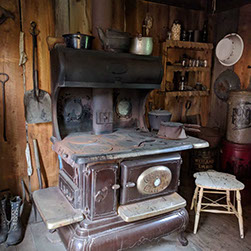
Photo courtesy of Audrey DeAngelis
Stove from the summer kitchen exhibit.
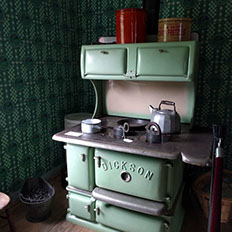
Photo courtesy of Audrey DeAngelis
Stove from the 1940's home exhibit.
Week Four 6/18/2018 - 6/22/2018
Touring Eckley: An Experience
By: Audrey DeAngelis
If you’ve ever wondered how we dig in the rain, well...we usually don’t. But we do still work. Wednesday morning was too wet for shovel testing, so into the lab we went! It’s an exciting feeling to pull something out of the ground, and then see it transformed from a piece of dirty trash to a shining fragment of someone’s old dinner plate. Okay, that doesn’t sound very impressive, but I had a lot of fun with it.
In the afternoon, we were able to get back to digging, but before that, we went on a tour of Eckley Miners’ Village. We visited three homes, the company store and the doctor’s office. Each of the homes was furnished to illustrate an immigrant family’s quest for the American Dream, from the second half of the 19th century to the 1940s.
At each of these sites, our guide was very helpful and patient with us while we started nerding out about spice tins, glass creamers, and other knick knacks. Most artifacts are only small pieces of what once were larger things. A little bit of detail in how the artifact was decorated or colored or manufactured can go a long way to identifying what it came from. So it’s a valuable thing for us to get to look at the kind of objects Eckley’s families owned and used, to imagine what those tools and toys might look like after decades in the ground, and to pick out little details in the design that might clue us in later to what we’re looking at.
A lot of my knowledge about material culture focuses on America’s earlier years. Coming to Eckley, there are a lot of things I recognize, but a lot that I’m still becoming familiar with. Not only did the tour help me to piece together more details of the Eckley story in my head, but it was a huge help for me to actually see the sorts of things miners and their families owned and used every day. It made me that much more excited to get back to work.
Week Three 6/11/2018-6/15/2018
Shovel Test Pits (STPs) and why they are important
By: Alessandra Portillo
How do you know where to dig? Why are you digging here? How come you are not digging over there? These are just a few of the common question that archaeologists encounter when asked about a why they are digging in a certain location. Despite what people have seen in movies and tv, archaeology is a very structured and scientific process and determining where to dig is an important part of this process. The first step in our process are Shovel Test Pits or STPs.
What is a Shovel Test Pit? A Shovel Test Pit is exactly what it sound like, a small pit or hole that we use to test for areas of cultural significance at a site. When an archaeologist start working on a site he or she will create a grid of the area and each coordinate of that gird is a potential dig site, during Phase I of an excavation those coordinates are where he or she will dig his or her STPs. The size of these pits can vary in size and depth depending on the site and the archaeologist’s purpose, but for this section I will be addressing the STPs our group is digging at the Rubin House in Eckley Miners Village, PA.
The STPs we are digging at the Rubin House are generally circular and about 1 foot in diameter. We try to keep them as cylindrical as possible as we work our way down and try to avoid the STP becoming conical, partly because that is standard, but it is also very difficult to dig in a conical hole. The depth of a STP varies depending on what we find or don’t find. When we dig a STP we dig in levels, each one-half of a foot deep and keep digging until we reach a new soil type or sterile subsoil, soil that does not contain any artifacts. That is not to say that if the first layer does not have artifacts we quit and move on to the next STP, we try to excavate a couple of levels just to make sure that the soil is in fact sterile. On the opposite end, we do not continue digging endlessly if we keep finding artifacts, mostly because that just is not very likely, we will sometimes encounter cases where it is just not possible to dig any farther without widening the pit or if we hit the layer subsoil, that is our cutoff point.
What is the purpose? As I mentioned earlier the purpose of a STP is finding areas of cultural significance. This means that we are looking for areas that may contain items that will give us greater insight into the people that lived in the area before. For our purposes, we are specifically looking for artifacts that give clues about the lives of the people when Eckley was still an active coal mining town. The STPs we have been digging since Friday will help us hone in on which areas will yield such evidence of cultural significance related to this purpose.
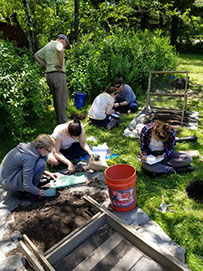
Photo courtesy of Kyla Cools
Crew members and volunteers counting artifacts from their shovel test pits!
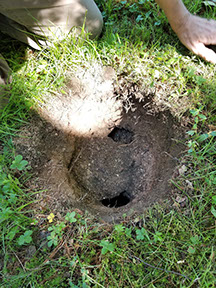
Photo courtesy of Kyla Cools
This test pit revealed a rodent run about a foot or so down! We didn't see which critter calls this home though.
Week Two 6/5/2017-6/9/2017
Recapping Progress From Week One
By: Kyla Cools
Our first week out in NEPA was an eventful one, giving new crew members an opportunity to familiarize themselves with the history of anthracite coal mining and Eckley Miners’ Village before starting work on the historic preservation component of our project this summer. The first full day the crew was in town we took a field trip out to Scranton to visit the Anthracite Heritage Museum and participate in the Lackawanna Coal Mine tour. The team got the opportunity to go behind the scenes of the Anthracite Heritage Museum and got a tour of the archives and collections storage from curator John Fielding.
Photo Courtesy of Paul Shackel
Field school directors Kyla Cools and Katie Boyle give a thumbs up from inside a deep mine ventilation shaft on the Lackawanna Coal Mine Tour.
Photo courtesy of Paul Shackel
Field crew members Alessandra Portillo and Audrey DeAngelis work on architectural sketches of 104 Main Street.
The following day the crew toured Eckley Miners’ Village and got to work beginning architectural sketches of double house #102/104 - where our preservation and archaeological work will be focused on this year. This property was selected because it is one of the longest occupied homes in the village and has had multiple additions made to it on both sides of the home. Through our work this summer, we hope to gain a better understanding of how residents altered and personalized company built structures to suit their individual wants and needs.
Once this work is complete the crew will begin laying out a grid to help guide our excavations! Be sure to check out our blog regularly for updates on our work and findings!
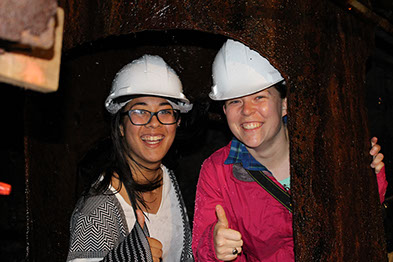
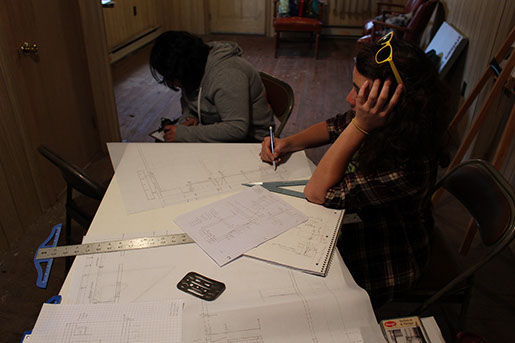
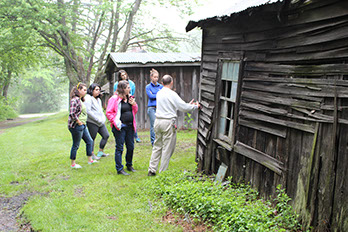
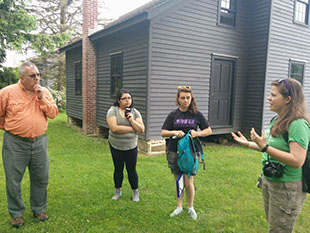
Photo courtesy of Paul Shackel
Field director Don Linebaugh discusses the Band House and outbuilding construction techniques with the field crew.
Photo courtesy of Laurence Bolduc
Field director Katie Boyle shows members of the field crew house lot #114 from summer 2017's excavations.

Photo courtesy of Katie Boyle
Field crew members Audrey DeAngelis and Alessandra Portillo continue work on architectural sketches of the interior of 104 Main Street.
Week One 5/28/2018-6/1/2018
Meet the Summer 2018 Field Crew!
By: Kyla Cools
Photo courtesy of Paul Shackel
The Field Crew took a day to don hard hats and explore the history of Anthracite coal mining in NEPA by touring the Anthracite Heritage Museumand participating in the Lackawanna Coal Mine Tour.
Pictured left to right: Paula Jarrett Nasta, Katie Boyle, Alessandra Portillo, Kyla Cools, Audrey DeAngelis, Laurence Bolduc, and Russel Bachert.
As we begin another season, we bring new faces and goals to the field. Like last year, we are incorporating a historic preservation aspect to our work this summer, and creating architectural drawings of double house #102/104 on Main Street, as well as performing archaeological excavations on the 104 side of the double house. Thanks to the hard work and dedication of our crew-made up of professors, students, and volunteers-we’re sure to get a lot of great work done and make some great memories! Read on for a brief introduction to our crew members and some highlights from our first week out in NEPA!
Dr. Paul Shackel is a professor of Anthropology at the University of Maryland, College Park. Creating the Anthracite Heritage Program in 2009, Dr. Shackel has been bringing university students out to NEPA to help explore and document the history of the anthracite region for close to a decade. Teaching students interdisciplinary methods such as collecting oral histories, performing archival research, and archaeological excavations, Dr. Shackel has been helping to provide a material dimension to understanding historic and contemporary issues related to work, labor, gender, and immigration in the anthracite region.
Dr. Don Linebaugh is a professor of Historic Preservation at the University of Maryland, College Park. Joining the Anthracite Heritage Program in 2016, Dr. Linebaugh is helping to teach students how to document and preserve the industrial heritage of the the anthracite region. Prior to joining the University of Maryland in 2004, Dr. Linebaugh served as the Director of the Program for Archaeological Research (PAR) and a Professor of Anthropology at the University of Kentucky.
Kyla Cools is a doctoral student in the Anthropology Department at the University of Maryland, College Park. This is her third year at Eckley. Specializing in historical archaeology and museum scholarship, Kyla is working to better understand the historic impact of injury and physical disability in industrial labor of the 19th and 20th century. Kyla graduated with a B.A. in Anthropology from Michigan State University.
Katie Boyle is a dual degree master’s student in applied anthropology and historic preservation at the University of Maryland and is a semester shy of graduating. This is her second year at Eckley. She is interested in the ways that archaeology can help us to understand the historic built environment and use of space, particularly in company towns. She graduated with a B.A. in Anthropology from St. Mary’s College of Maryland.
Dolly Canevari is returning for her third year at Eckley Miners' Village. She received her BA in anthropology from the University of Rochester and is currently a graduate student at Vrije Universiteit Amsterdam. Dolly is hoping to pursue a career in public interest law, and is interested in how past poverty impacts life today.
Paula Jarrett Nasta is presently a doctoral student at the University of Maryland School of Architecture, Planning and Preservation. She holds a Master of Historic Preservation from the University of Texas at Austin, a Bachelor of Architecture Degree from Florida Atlantic University, and a Bachelor of Arts in History from Florida International University. Her research includes vernacular building techniques in Texas, the impacts of design on community, and the use of state historic tax credits by low income homeowners. Her current research examines the impact of women’s changing societal roles on the design and development of late twentieth century suburban communities.
Laurence Bolduc is a visiting PhD student in anthropology from the University of Montreal in Quebec, with a master’s degree in Anthropology from Trent University in Ontario, Canada. Her current dissertation focuses on early twentieth century lumber camp sites in the Temiscouata region in Quebec. Through public archaeological excavations and oral history, she aims to engage the local community in the investigation of their own local industrial heritage and explore the daily lives of worker’s communities in remote lumber camps.
Audrey DeAngelis is an incoming PhD student at the University of Maryland and received her Bachelor’s degree in anthropology from James Madison University. She has worked as an historical interpreter and tour guide for colonial heritage sites for over five years. Her academic interests include wealth disparities, immigration and ethnicity, and labor history.
Alessandra Portillo, is an undergrad anthropology student at the University of Maryland-College Park. Before she decided to pursue anthropology, she earned a B.A. in criminology and criminal justice from UMD. She plans to earn her B.S. in anthropology and later go into forensic anthropology.
Russ Bachet was raised in the coal regions of NE Pennsylvania. His Father was born in Quakake, PA and his Mother in Delano, PA. Most of the male members of the family were employed by the Lehigh Valley Railroad company which transported coal. He was raised in a double home built for a railroad company boss and later sold to individuals. It would remind one of Eckley Miners’ Village, only on a much grander scale. His great-grandfather came from Wales and settled in the small town of William Penn to work in the mines. His grandfather would also wok in the same minefields as a "breaker boy" and later his father was a welder for a "strip-mine" operator in Hazleton, PA. Russ studied at the Millersville University of Pennsylvania to become an elementary school teacher and his first job was for the Mahanoy Area School District, Mahanoy City, PA. He returned back to NE Pennsylvania in 2006 and now lives in Bloomsburg, PA where he devotes full-time to the family he adopted from Bolivia. His wife and two teenagers were born and raised in Bolivia. He is a member of the Mahanoy Area Historical Society and started to study the field of anthropology at the Bloomsburg University of Pennsylvania this past spring, 2018, generating his interest in the Anthracite Heritage Project.
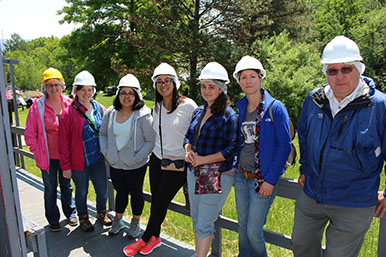
Sponsored by the University of Maryland Department of Anthropology
1111 Woods Hall, College Park, MD 20742
(c) 2015 V.C. Westmont
Contact us with feedback, questions, or concerns